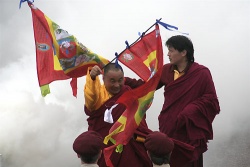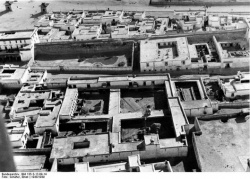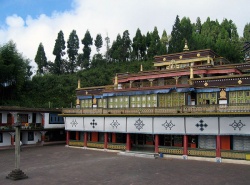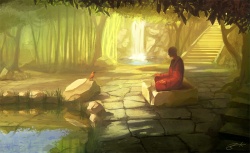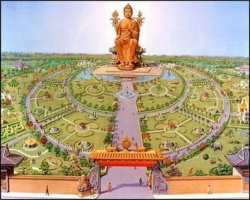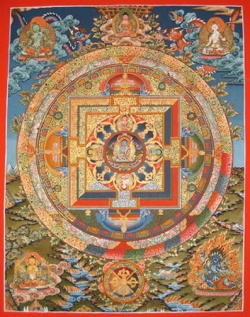Mineral raw materials in Tibetan Medicine by Dr. Natalia Bolsokhoeva
BRIEF HISTORY OF TIBETAN MEDICINE
During the reign of one of the most powerful kings of Central Asia Srong btsan Gonbo (reigned between 629-649) Tibetan written language appeared and translation of medicine books in Tibetan language started. In this way, Tibetan medicine adopted the knowledge about diseases and their medical treatment from the books of Indian medical science Ayurveda, and the art of pulse diagnostics and the teaching of five elements – from Chinese medicine. Also Tibetan medicine was influences by Greek-Roman Arabian and Persian medical systems.
Medicine in Tibet was for all times closely connected with Buddhism. That is why mainly traditional Tibetan doctors are lamas (monks). Medical teaching was not forbitten for women also. In previous time many famous practitioners were women. Hospitals and pharmacies were situated within the monasteries, and in the most prestigious Buddhist universities manba datsangs (medical faculties or schools) were established. The strong connection with Buddhism is reflected in the fact, that the causes of diseases are often connected with reincarnation, it is considered that they are brought from previous lives. In their treatment a certain number of rituals, mantras, special meditation practices are used; great attention is paid to spirituality and morality. The attempts to separate Tibetan medicine from Buddhism were always unsuccessful.
The main treatise on Tibetan medical culture is a fundamental (Root) text “rGyushi” (rgyud bzhi, “Four Medical Tantras”). In four volumes of this treatise, consisting of 156 chapters corporal and spiritual causes of disease, healthy way of life, detailed descriptions of diseases, their treatment, principles and methods of diagnostics, principles of drug treatment, procedures and other means are given. The “rGyushi” is not a canonical text, as is not incorporated into the Kanjyur and Danjyur collection.
There are 84000 of different health disorders distinguished in Tibetan medicine. According to the opinion of the most eminent Tibetan emchis, the number of diseases is equal to the number of the sick people. It is considered each disease of each person is individual and is not like the disease of the other. Tibetan science of healing based on a correct understanding of the body and its relationship to the environment are classified all diseases into 404 types. They are divided into four kinds. 101 types are of karmic diseases. Such types of sicknesses are difficult to treat with a normal medical treatment and demand spiritual techniques. 101 – inner diseases. 101 kinds are diseases caused by spirits (they could be classified by terms of modern medicine as nervous and mental diseases). 101 are manifested in the body appearance and are cured by the diet changing or by the refusal of the habits, which caused the disease.
The causes of diseases in Tibetan medicine are explained according to the theory of three energies or three dosha (lung, mkhis pa and badkan). As Tibetans say, three energies – wind, bile and phlegm are the basis of living nature. There exist seven types of constitution. Individual correlation of these energies in each person predetermines not only his physique, but also inclination for one or another disease. For instance, if bile is dominating, the person is more hot-tempered and is disposed to indigestion and heart and vessels diseases; people of wind type – are thin, melancholic, more often have articulation diseases and nervous disorders. If phlegm prevails – the body is inclined to grow stout, and the diseases characteristic of this type – are metabolism disorders. The ideal correlation, when each of the energies has equal amount in the body, almost never occurs. Depending on the life conditions, nourishment and spiritual state, this correlation is always changing.
In Tibetan medicine diseases are also divided into two groups – that of “cold” and “heat”. This corresponds to western characteristics of chronic and acute illness. In the same way Tibetan medicine is divided into medicine for curing “cold diseases” and medicine, suppressing “heat”. At the same time can be of different kinds of medicines also, and there are a number of medicaments for curing bile, wind and phlegm diseases. At previous time Tibetan doctors did not know such names as diabetes, tuberculosis or inflammation. That is why Tibetan analogues of diseases sound strange for us, for example, “hidden heart heat” corresponds to diagnosis of ischaemic heart disease, or “kidney cold” – insufficiency of kidney functioning.
MINERAL RAW MATERIALS IN TIBETAN MEDICINE
According to Tibetan medicine there's nothing on the earth one can't use as a medicine.
Tibetan pharmacy generally uses multi-component preparations rather than those consisting of a single drug. While pills are by far the most common form of preparation, formulations may other forms as well. In Tibetan formularies the necessary ingredients for a given multi-component preparation are first mixed together based on the doses described in pharmacological guidances, special prescription books and then they are ground into powder. Tibetan medicinal preparations therefore consist most commonly of a combination of substances. Most ingredients are herbal, although mineral and animal substances are widely used as well. Multi-component medicines are usually more drastic, than one-component, because each component influences its part of disease and intensifies systemic effect. As a rule Tibetan medicines do not have side - effect. Tibetan drugs can be in the form of powder, pills, oils and also in the exotic for us forms –medical incenses. In this case on the boxex of incenses will be writing remark “Healing insenses”.
Medicinal compositions are traditionally made by doctors themselves. Unique recipes, which are used today, were thoroughly composed, transmitted and checked through many centuries by many generations of the most eminent traditional Tibetan doctors (emchis).
I am starting my topic concerning the mineral raw materials in practical Tibetan medicine. I discovered, it is quite complicated aspect of Tibetan medical culture and I did not find any special studies, investigations or publications about this important branch of Tibetan Materia Medica, which were done by Western scholars or scientists. It is well - known, wide account of raw materials: plants, herbs, animal and mineral raw materials are given in the Root text on Tibetan medicine”rGyushi” (“Four Medical Tantras”), the most profound and huge commentary “Vaidurya onbo” (“Lapis Lasuli”), composing by remarkable scholar and a great politician of the medieval Tibet Desi Sangye Gyatso (1653-1705) and widely circulated for centuries guidance on the Tibetan pharmacology and pharmacognozy, entitled “Shel phreng” (“The Crystal Rosary”). The last treatise was complited by one of the most important authorities in the pharmacological and pharmacognostic fields Deumar (sometime in Tibetan literature uses spelling Dilmar). Geshe Tenzin Phuntsog born in 1672, the date of his death is unknown. Let’s me tell about his life in .brief. Unfortunately, few facts are known about Deumar geshe Tenzin Phuntsog (in the history of Tibetan medicane he is mainly known under his short name Tenzin Phuntsog).
The biographical review of his life and fruitful activities was made by outstanding modern Tibetan intellectual and emchi, Prof. Pasang Yonten in his profound monograph “The Historical Survey of Tibetan Medical Science”, writing in Tibetan. It published by the Yuthog Institute of Tibetan Medicine Choglamsar. Accoding to this bibliogpaphy, Tenzin Phuntsog was born in Gojo dzong in the Nangrig lineage of the great healing master Tsampa Shilahade, who came from the land Trom (Tib.: Khrom) during the reign of Tibetan king Meagstom (another name is Thride Tsukten, reigned between 704-754/55?). From his childhood Tenzin Phuntsog studied classical Buddhist sciences under supervision of the great Buddhist masters and scholars of that time. He obtained authoritity in the three modes of scholarship (teaching, debate and compound) over Sutra, Tantra and other important fields of knowledge from his numerious eminent teachers. It is difficult to imagine in Lagten Cedue future geshe Tenzin Phuntsog practiced as doctor since he was eight years old and according to acarya Pasang Yonten, he already had unique knowledge in many aspects of theory and practice of Tibetan science of healing.
Tenzin Phuntsog was a holder of the geshe degree (a doctor in philosophy). In bibliography, complited by Pasang Yonten, is said, he obtained this degree from the prestigious Drepung Monastic University, in Central Tibet. The author did not give any details about life and studies of Tenzin Phuntsog at the Drepung. Obviously he studied at the philosophical faculty (mtsan nyid) of the Drepung Buddhist University. It could be famous Goman (word for word “Many doors”) datsan within one the biggest monasteries of gelugpa school Drepung. Goman datsan is well known faculty in the area of Buddhist philosophy. It might be here he participated in the final philosophical debate and received degree of geshe.
Geshe Tenzin Phuntsog extensively traveled throughout Tibet, spent many years in the scientific expeditions, learned and analysed rich flora and fauna of his own land. In addition he had put energetic efforts in profound research of mineral resources of many geographical zones of Himalayan region such as coal, borax, chromium, lithium, uranium, gold, silver, iron, copper, mercury and semi-precious stones. Prof. Pasang Yonten in his monograph gave a list of the works, compiling by of Geshe Tenzin Phuntsog. It consists of the 61 titles of works on the most complicated aspects of Tibetan culture, among them 25 texts on Tibetan science of healing and astrology. Traditionally in Tibetan culture those subjects have very closed links. The profound works of Geshe Tenzin Phuntsog still did not lost their value and studied by modern emchis and medical students in Tibet, India, Bhutan, Nepal, Russia and Mongolia. Deumar geshe Tenzin Phuntsog was considered as representative of the many professions in large. He was a physician, philosopher, philologist, mineralogist, geobotanist, zoologist and astrologist. We can tell he was a personality of subtle intellect. Geshe Tenzin Phuntsog left a great number of the most celebrated and competent disciples, who continued his important investigations and recognized as the successors of his medical traditions, the scholars of authority. They did big contributions to the development of Tibetan science of healing and medical literarure. I can say the discilples of Geshe Tenzin Phuntsog continued his tradition in all aspects of medical knowledge.
According to the history of Tibetan medical culture, only at the very beginning of the XVIII century pharmacology and pharmacognozy became independent disciplines of Tibetan medical science. In treatise “Shel phreng” is reflected the historic process of creation of a number of other natural sciences. In the text is available information on such sciences, as mineralogy, botany, zoology, systematic and morphology of the plants, animals and minerals. All mentioned sciences were completely new for Tibetan culture at that time.
The “Shel phreng” compiled in 1727 is the principle source for the present study and research. From the beginning the work of geshe Tenzin Phuntsog was well received by Tibetan specialists in the area of Tibetan science of healing. My study is based on the Tibetan text “Shel phreng”, printed at the publishing - house of well-known Aginsk datsan (Buddhist monastery, Chita area), famous for his high quality printing and paper of the factories No. 6 or 7, named after Sumkins. Before the Great October Revolution those factories were located in Irkutsk. Highly-educated Buryats had good knowledge about the quality of paper and used to go to Irkutsk to buy it at the Sumkin’s factories. Some of the professional Buryat editors became permanent costumers of the Sumkin’s factories and had good experiance, how to select paper for printing of blockprints in Tibetan and old Mongolian.
Xylograph of “Shel phreng” of the Aginsk edition contains 233 leaves (466 pages), size of leave is 54,5 x 8,7 sm, size of the leave’s frame is 48 x 6,5 sm., each leave has six lines. Some specialists talk about the different editions of “Shel phreng” At least five editions are known for me[1]: the Derge (Eastern Tibet)[2], Aginsk, Urga, modern edition, published in Dharamsala and facsimile edition of the Chagpori blockprint of 1905, produced in Leh in 1970.
Derge edition edited by Ogyen Namgyal was republished by the modern Tibetan emchi and skilled publisher Dr. T.Y. Tashigang[3] in Leh (Ladakh). The Derge, Aginsk and Urga editions are available at the Centre of Oriental Manuscripts and Xylographs of the Institute for Mongolian, Buddhist and Tibetan Studies of Siberian Branch of Russian Academy of Sciences in Ulan-Ude. In Transbaikalia region “Shel phreng” of the Aginsk edition was extensively used by the traditional Buryat doctors in their medical practice, especially for the classification of a large number of raw materials. From their point of view “Shel phreng” is a masterpiece in the history of Tibetan pharmacology and pharmocognozy. It is still the significant guidance and reference book for study and correct understanding of the most complicated classification of Tibetan drugs, their physical properties and pharmacological effects. All those aspects are major subjects of study.
Text of Tenzin Phuntsog is the only full work written in Tibetan, where we are able to find the most detailed descriptions of raw materials in general and mineral raw materials in particular. It is the main reason, why I pay special attention to this unique source of Tibetan medical culture. The analysis of the contents of Tibetan text of “Shel phreng” shows that it has quite complicated structure. According to the Buddhist tradition treatise has three parts: introduction, main part, where the author introduced the concept of his deep research and conclusion. It should be noticed the Aginsk edition of “Shel phreng” has not the author’s and publisher’s colophons, therefore we are not able to get important facts, concerned with the reason of composing the fundamental monograph, in which Tibetan monastery was done this titanic work, how many years the author spent to complete this huge in volume guidance. There is no any information, who ordered the working out the“Shel phreng” and who was a donor/donors of this edition. For lack of the publisher’s colophon does not give opportunity to find out the year of publication of the Aginsk edition and names of editor/editors and sponsor/sponsors of edition. Such important data could give us some orientation about the Buryat intellectuals, who took a special interest in valuable source for traditional Buryat physicians and medical students to cure locals suffering from serious sicknesses. Finally we do not know from which edition was republished the Aginsk edition.
I am going to describe the structure of the treatise “Shel phreng” in brief. As it was above mentioned the text is divided into three large chapters. I concentrate my mind on the main one, in the original text is number 4. It is entitled “The contents of the treatise are cleared up the main point of medicinal characteristictics and names of remedies in detail” (f. 12 b.-22 b). Numeration of the leaves is given according to the Aginsk edition of “Shel preng”. Material of chapter 4 is divided into 13 branches (4.2. - 4.2.13). Five branches give descriptions of the vegetable raw materials and seperated branch is contained chatacteristics of a large number of herbs. Five branches deal with mineral raw materials. Hydroparthy and acupuncture are important methods of treatment in practical Tibetan medicine are discussed in the branches 4.2.11 and 4.2.12. Analysis of mixture and herbal potion is done in the branch 4.2.13.
It should be mentioned the composer did many years project to collect, store, study and research a great number of vegetable, animal and mineral raw-materials and introduced their detailed descriptions. Here my special interest goes in the mineral raw-materials. It is widely spread opinion, Tibet as sacred territory is rich in mineral resources, such as natural metals, gemstones and semi- stones, precious minerals, salts and so on. They are analysed in the five branches (from 4.2.1 to 4.2.4 and 4.2.8) of main chapter of “Shel phren”. The branch 4.2.1 has title “Remedies from precious metals” (f. 12 b. - 35 b.); next branch 4.2.2 is entitled “Remedies from stones and minerals (f. 35 b. - 51 a): Branch 4.2.3 has title “Powedered remedies of mineral origin” (f. 51 a. - 55 a.); branch 4.2.4 has name “Extracts of remedies of the vegetable, animal and mineral raw materials (f. 55 a. - 69 a). Branch 4.2.8 is contained the classification of various kinds of salts (f. 183 b. - 191 a).
Based on the authoritative information of Algirdas Kugevicius, my Lithuanian collegue, a highly-learned scholar, famous for his professional translations of Tibetan philosophical, tantric and medical texts into Russian and Lithunian, in “Shel preng” knowledgeable scholar and scientist Tenzin Phuntsog discussed 900 various types and sub-types of minerals, including metals. It means more or less 1/4 of profound book of Tenzin Phuntsog deals particularly with minerals and metals. Algirdas in the collaboration with Donatas Butkus, an eminent Lithuanian pharmacognost translated full Tibetan text “Shel preng” into Lithuanian. The manuscript of the translation consists of 927 pages and now they involve in editing of this bulky work. The translation of Tibetan text of “Shel preng” took more than seven years to complete it. It is honour for me to write introductory scientific article to this brilliant translation of Lithunian specialists.
Unfortunately there is still no translation of this important source (even partly) into any Western language; however this manual is one of the most key reference books for the scientists and practioners who involve in studying and practicing the Tibetan science of healing. Not many specialists know, full Tibetan text of “Shel preng” translated into modern Chinese. I am not a sinologist and I am not able to tell about the quality of translation. In the addition of this translation there is appendix of Latin and Chinese names for each medicament. It is really big contribution of Chinese collegues to the identication of natural raw materials using by Tibetan medical practitioners. It is one of the most complicated aspects of Tibetan Materia Medica. It published by the Shanghai Press of Science and Technology in 1986. In 1975 “Shel preng” was translated into old Mongolian language, which was official literary language of Buryats until 1931. This translation was done by competent Buryat specialists in the area of Buddhist philosophy and emchis L.Ya. Yampilov, Z.Z. Zhapov, M.D. Dashiev and is kept at the Centre of Oriental Manuscript and Xylographs of the Institute of Mongolian, Buddhist and Tibetan Studies of Siberian Branch of Russian Academy of Sciences. At present two translations into Oriental languages are existed, they are useful sources for description and studies of natural raw materials, analyzing in “Shel preng”.
Detailed descriptions of raw materials in “Shel preng” give a unigue possibility to start deep research of the comparative investigations with depictions of the “Atlas of Tibetan Medicine”, consisting of the 76 plates. The set contains about ten thousand paintings, depicted in beautiful colours. Since 1936 this treasure of Tibetan medical knowledge is kept at the History Museum of Buryatia named after M.N. Khangalov[4] (previous name of the Buryat - Mongolian Antireligious Museum, opened in 1937 in Ulan - Ude).
Geshe Tenzin Phuntsog worked out specific system of a detailed description of raw materials. This micro - structure is following:
- 1). Title of remedy;
- 2) Thesis from the Root text “rGyushi” with indication of the use of this remedy;
- 3). Citations from various sources, composed by earlier authorities about pharmacological effectiveness of certain kind of raw materials;
- 4). Various names of certain raw materials with indication names, synonyms, sacred names, for the imported raw material or adopted from other countries. In such cases the author gave the names of the countries from where raw materials originated, and equivalents in Chinese, Sanscrit, Tokhar[5], Mongolian and so on. It is important to underline Tenzin Phuntsog knew several foreign languages and had good linguistic attainment.
- 5) Geographical dissemination, ecological knowledge, the area of the mining for mineral raw materials (for example gold, its quality, sort, effectiveness and prescription).
- 6). Inner classification of certain raw materials, names of each type with indication of its outer form of leaves, stems, fruits, roots, rhizomes, colours of flowers and leaves.I have to tell you very openly, it was not easy to understand the point No. 6, concerning the inner classification. Reading the Tibetan text of “Shel preng” and try to understand it completely I found out this classification deals with such characteristic as for example colour of flowers of plants, trees or minerals. Here I give only two samples: first one is Sandal tree (white and red) and second one is blue, white, and yellow beryl. The author noted, they are different kinds of the same tree and mineral, but he underlined the main difference are quality and effectiveness. The second characteristic connects with geographical spreading; in “Shel phren” are noticed raw materials from India, China, Tibet, Nepal, Dolpo and Kashmir.
- 7).Secrets of time of the collection of raw materials. In this chapter the composer created special instruction for the collectors. The main point of Geshe Tenzin Phuntsog lies in the fact that traditional Tibetan physicians, who participated in the seasonal expeditions, should strictly follow this instruction and learn it by heart.
In fundamental source “Shel phren” classification of the 3470 titles of vegetable, animal and mineral raw materials are introduced. 1176 names we are able to find in the “rGyushi”, “Vaidurya onbo” and “Shelgon”. Last treatise is written by Geshe Tenzin Phuntsog in sloka style for easier memorizing not only by medical students but emchis as well. 2294 titles are classes, sub - classes, types and sub - types of the above mentioned 1176 remedies. A systematic description is based on the created classification by Geshe Tenzin Phuntsog, consisting of the seven key points, noted above. The research of the text shows from point of view of the composer, exacted knowledge of names of remedies, their classes, sub-classes, types, sub-types was necessary for the clinical pharmacology and for practice of medical activities. Emchis should understand that the effectiveness of treatment is depended on kind, sort and colouring of ingredients.
[[Tibetan medicines show various medical and pharmacological characteristics. I would like to give a sample. It is well-known widely spread mineral raw material brag zhun (shilagit), a mineral of black colour. The most curative shilagit is available in the highest Himalayas. In the Tibetan pharmacy are spread the liver, kidney, skin formulas. Similar recepies were widely circulated in the medical system of ancient India Ayurveda for many thousand years. Last many decades the representatives of a number of modern specializes engage in serious research of this mineral. In “Shel phren” is said in our nature five various classes of shilagit (brag zhun) exist. Each one in its turn has sub-classes, sub-types and sub-kinds. The author Tenzin Phuntsog concludes in total there are 115 different types of brag zhun and physician must be very careful and should be very skilled to select the correct kind of brag zhun as ingredient based on the prescription books, when he composes multi-component medicines for certain pathology.
The second sample is connected with turquoise, national Tibetan stone. In Tibetan culture and literature there are a large number of stories and legends about this fantastic stone and its curative power. In “Shel phren” detailed descriptions of twelve kinds of turquoise are introduced. Tenzin Phuntsog classified turquoise based on the Indian and Tibetan system of classification. In his treatise four kinds of turquoise are classified according to the Indian system, and eight kinds are classified according to the Tibetan classification. However the author Tenzin Phuntsog did not describe the concept of two systems of classification, therefore it is not easy to understand completely the difference of those systems. Probably the Indian classification was borrowed from India, but we don’t have any knowledge about it. For example in the “Atlas of Tibetan Medicine” six types of turquiose depicted (plate No. 23, paintings No. 41-46): No 41 - blue turquoise with shot white, No. 42 - blue turquoise with shot red, 43 - poor turquoise, 44 - turquoise of not high quality like turquoise with shot red, 45 - dark blue turquoise reminds turquoise with shot white and No. 46 - Chinese turquoise.
Let’s me tell the third sample. I am going to describe beryl (in Sanskrit vaidurya), the precious mineral. Actually this name borrowed from ancient Greek, beryllos, and word for word means "precious blue-green color". As natural resource beryl is available in Colombia, Africa, Brazil, Russia, Pakistan, Sri Lanka, India and California. We can say without any doubts, that the geographical zone of the spreading of this mineral is not Tibet. It was imported from other countries. Thanks to this fact we are able to state why this precious stone does not have Tibetan name. In Tibetan literature beryl is known under its Sanscrit equivalent vaidurya, it is considered that is of Dravidian origin, maybe from the name of Belur. Traditionally Mongols and Buryats pronounce the name of this mineral as baidurya and pay special respect to its beauty and quility. Beryl belongs to the silicate class. At the XVIIth and beginning of XVIIIth centuries the chemical formula of this mineral was unknown. In Tibetan culture blue, yellow and white beryls are known. This mineral was a favourite one of the remarkable Tibetan scholar and regent Desi Sangs Rgya mtsho. He created a great number of huge treatises writing on different branches of the medieval Tibetan sciences. He entitled his books as “Vaidurya dkarpo” (“White Beryl”), “Vaidurya onbo” (“Blue Beryl”) and “Vaidurya serpo” (“Yellow Beryl”). Desi Sangs Rgya mtsho wrote his fundamental books “between” 1683-1698. Their titles underline his special attude and respect to this sacred stone which has strong energy and curative effectiveness.
The cult of beryl played special role in the Indian and Tibetan culture. In “Shel phren” is said there are extensive references to beryl as a gemstone in folklore of India and Tibet. For more information about beryl's powers and curative attributes, consult some of the books such as “Vaidurya onbo” and “Shel phren” Legend says that beryl was used to ward off demons and evil spirits. In Tibet there is popular story that beryl is protected travelers from danger and to treat disorders of the heart and spine.
Geshe Tenzin Phuntsog underlined that precious minerals should be detoxified before use as ingredients for the composition of multi-component Tibetan medicines. Each emchi should strictly follow the rules of technology in the preparation of medicaments and bear responsibility for their guility and effective.
My premiry studies show, that the most complicated aspect in the field of the investigation of mineral raw material is its identification. It is happened difficult to find correct equivalents for a large number of precious minerals, metals and gemstones. I have a lot of difficulties with various names of the metals widely use in Tibetan pharmacology. For example in “Shel phren” I met more than 70 (probably 73) names for gold, 21 names for silver, 28 names for copper, 25 names for iron, 61 names for mercury and so on. In some cases the author is considered much better to introduce the graphic descriptions of raw materials however difficulties arose to understand and translate, when we do not have enough knowledge of realities of Tibetan culture. It is not easy to find right answer, in which cases and why the composer uses certain sorts of metals. It is possible to get some answers concerning the various sorts of gold from the depictions on the plate No. 23 of the “Atlas of Tibetan Medicine”, illustrating the chapter 20th of the second volume of two key treatises “Four Medical Tantras” and “Lapis Lazuli” Here seven kinds of gold (depictions No. 19-26): are painted. I’ll give the names of several types of gold, painting on the plate No. 23: No. 20 golden alloy, No. 22 yellow-red gold available in modern Kham or No. 24 greenish gold of modern Mongolia and so on. Regarding copper (drawings No. 36-39): painting No. 36 is native copper, No. 38 - red soft copper containing gold and etc. I would like to note, the “Atlas of Tibetan Medicine” is a unique visual aids on many aspects of Tibetan medical science. Unfortunately in its corpus there is no special plate with depictions of minerals, metals and stones. Total number of mineral raw materials, drawing on the plate No 23 is 131 names (drawings No. 16-147), they illustrate chapter 20th.of the ”rGyushi” and “Vaidurya - onbo”,. The 20th.chapter of “Vaidurya - onbo,” has title “Components of Tibetan Remedies making from jewels“. We can conclude, that the “Atlas of Tibetan Medicine” contains only 1/7 part depictions of mineral raw materials described in the text “Shel phren”.
Now a brief conclusion comes. My primery investigation shows, that serious research and huge in volume work should be done. It is hard and complicated work and is necessary to join efforts of the representatives of many specialities. Tibetologists, Mongolists, Sinologists, Indologists, botanists, minerologists and scientists who have deep knowledge about all aspects of rich Tibetan medical culture, traditional Tibetan doctors, who practice Tibetan science of healing and have enough experience to cure ill people and to compose multi-component Tibetan effective medicines. It is the most important investigation should be done in several stages: first of all it is necessary to translate Tibetan text “Shel phren” into Russian or any Western languages and then step by step do research of the contents of the text. It should be many years project, which could give good results and useful materials for the development of various modern disciplines.
REFERENCES
Primary sources
- Bris cha (“The Atlas of Tibetan Medicine”), consisting of 76 plates. The History Museum of Buryatia named after M.N. Khangalov. Ulan-Ude: Inv. No. 15. A. 18-79. Sizes of the plates 65x88.
- Bris cha (Illustrations on Tibetan Medicine of the Atsagat Manba datsan). The History Museum of Buryatia, named after M.N. Khangalov. Ulan-Ude: OF 8281.
- Pasang Yonten. Historical Survey of Tibetan Medical Science (bod kyi gso ba rig pa'i lo rgyus kyi bang mdzod gyu thog bla ma dran pa'i pho nya). Yuthog Institute of Tibetan Medicine. Choglamsar, Leh, Ladakh, India. 1986. (in Tibetan). 313 p.
- Tenzin Phuntsog Shel ‘phren. Aginsk Edition, the end of the XIX c. 233 f.
Secondary sources
- «Атлас тибетской медицины». Свод иллюстраций к тибетскому медицинскому трактату XVII века «Голубой берилл». 1994. Вступительные статьи Н.Д. Болсохоевой, Д.Б. Дашиева, В.С. Дылыковой - Парфионович, К.М. Герасимовой, Л.Э. Мялля, Т.В. Сергеевой. Перевод текста атласа Т.А. Асеевой, Н.Д. Болсохоевой, Т.Г. Бухашеевой, Д.Б. Дашиева. Пояснительный текст к листам атласа составил на основании исследования тибетских медицинских трактатов «Четверокнижие» и «Голубой берилл» Ю.М. Парфионович, из-во «Галарт», М.,592 c..
- Bolsokhoyeva N.D. and Gerasimova K.M. The Atlas of Tibetan Medicine. Treasure from the History Museum of Buryatia in ‘The Buddha’s Art of Healing. Tibetan Painting Rediscovered. Foreword by His Holiness of the Dalai-Lama. New York: Rizzoli, 1998, pp. 33-60.
- Bolsokhoyeva N. D.Tibetan Medical Illustrations from the History Museum of Buryatia, Ulan-Ude in Asian Medicine. Tradition and Modernity. Leiden. Brill Academic Publishers, vol. 3. No. 2. 2007, pp. 347-367
Footnotes
- ↑ I borrowed this important information from a Lithunian scientist Algirdas Kugevicius.
- ↑ The Derge edition was reprinted under title: Dri med śel goṅ and dri med śel phreṅ: Presentation of the Principals of Tibetan Pharmacognosy and Materia Medica Leh, 1983. It is necessary to notice here the editors reprinted two key texts on pharmacology and pharmacognozy together, composing by Tenzin Phuntsog
- ↑ Dr. Tashigang originally is Ladakhi; he graduated from the Lhasa Mentsikhan, established on the initiative of the XIII Dalai Lama Nawang Thubten Gyaso (1876-1933) by his private physician Kyenrab Norbu (1883-1962) in 1916. He learned Tibetan medicine under guidance of this of the most eminent emchi Kyenrab Norbu. Dr. Tashigang runs the Tashigang Herbal Centre in New-Delhi. He is a founder of this Centre, director, skilled emchi and authoritative editor of a great number of rare Tibetan Medical texts. He is an outstanding specialist in Tibetan pharmacology.
- ↑ In 2010 it was renamed, now is National Museum of Buryatia.
- ↑ It was spread in the Eastern Turkestan, modern Chinese province Sichuan until VI - VII centuries B.C.
Source
Author: Dr. Natalia Bolsokhoeva
buddhismandaustralia.com
